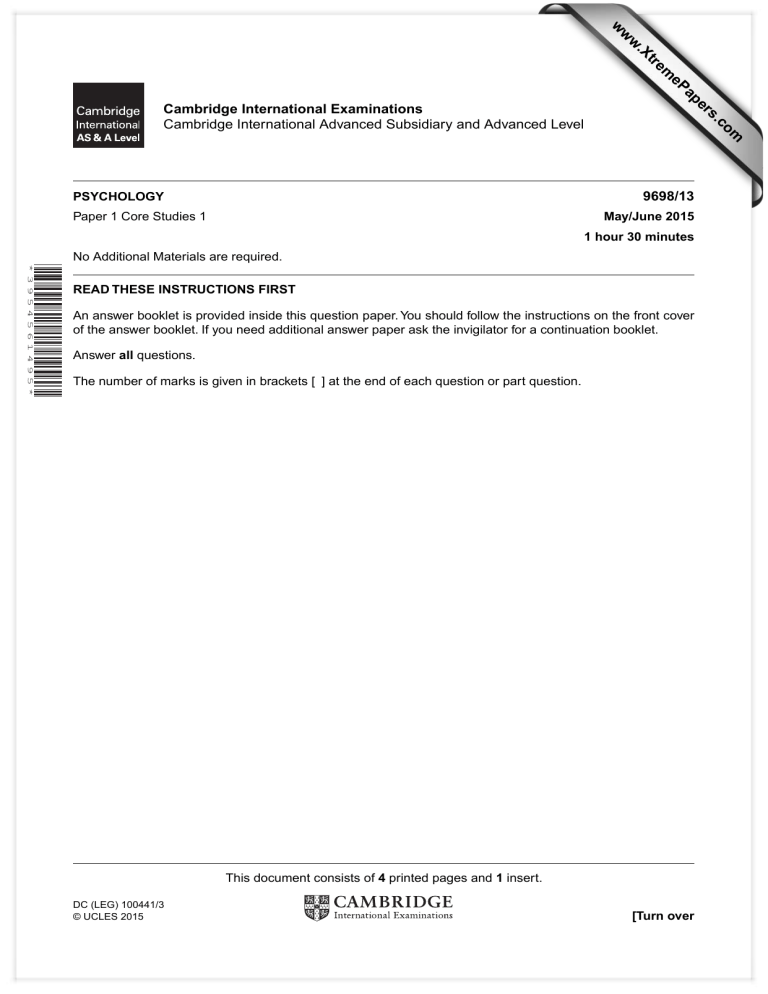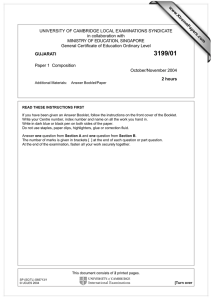www.XtremePapers.com Cambridge International Examinations 9698/13 Cambridge International Advanced Subsidiary and Advanced Level
advertisement

w w ap eP m e tr .X w om .c s er Cambridge International Examinations Cambridge International Advanced Subsidiary and Advanced Level 9698/13 PSYCHOLOGY Paper 1 Core Studies 1 May/June 2015 1 hour 30 minutes No Additional Materials are required. * 3 9 5 4 5 6 1 4 9 5 * READ THESE INSTRUCTIONS FIRST An answer booklet is provided inside this question paper. You should follow the instructions on the front cover of the answer booklet. If you need additional answer paper ask the invigilator for a continuation booklet. Answer all questions. The number of marks is given in brackets [ ] at the end of each question or part question. This document consists of 4 printed pages and 1 insert. DC (LEG) 100441/3 © UCLES 2015 [Turn over 2 Section A (60 marks) Answer all questions in this section. 1 2 3 4 5 6 In the study by Mann et al. (lying) they suggested that an important comparison had been omitted, one between high-stakes liars who deny an offence they have committed with high-stakes truthtellers who plead innocence when falsely accused. (a) Describe why this omission was important. [2] (b) Suggest one factor that could be controlled in this new comparison. [2] From the study by Held and Hein (kitten carousel): (a) Describe how the exposure apparatus was given ‘texture’ (a visual pattern). [2] (b) Why was this visual pattern important to the experiment? [2] From the study by Piliavin et al. (subway Samaritans): (a) Explain how qualitative data were collected in the study. [2] (b) Describe two qualitative findings from the study. [2] During the study by Bandura et al. (aggression) the researchers took each child into a room containing attractive toys with which they were allowed to play for a short time but were then told to leave. (a) Identify two toys in this room. [2] (b) Explain why this part of the procedure was necessary. [2] In the study of little Hans, Freud notes that there are both advantages and disadvantages to using children in research. (a) Describe one possible advantage of using a child in this study. [2] (b) Describe one possible disadvantage of using a child in this study. [2] In the study by Langlois et al. (infant facial preference) comparisons of fixation time were made between high and low attractiveness faces. (a) Describe the results from study 1 (white male and female faces). [2] (b) Describe the results from study 2 (black female faces). [2] © UCLES 2015 9698/13/M/J/15 3 7 8 9 From the study by Nelson (children’s morals): (a) Explain what was meant by ‘outcome’. [2] (b) Explain why Nelson believed it was necessary to investigate the effect of outcomes. [2] In the study by Schachter and Singer (emotion) the physical effects of epinephrine were measured using self report scales. (a) Describe the scales used to measure the effects of epinephrine. [2] (b) Identify one strength and one weakness of the scales. [2] From the study by Dement and Kleitman (sleep and dreaming): (a) Describe the findings relating to average sleep time. [2] (b) To what extent are these findings likely to be typical of the normal sleep times for these participants? [2] 10 In the study by Maguire et al., the taxi drivers were required to describe famous landmarks. (a) Describe the procedure of this task. [2] (b) Identify one task that the landmarks task was compared to, and say why it was important. [2] 11 From the study by Demattè et al. (smells and facial attractiveness): (a) Describe the results for facial attractiveness with pleasant compared to unpleasant smells. [2] (b) Describe the results for facial attractiveness with pleasant smells compared to the control condition. [2] 12 In the study by Rosenhan, he concludes that physicians have a bias that makes them see a sane person in hospital as insane. There are other possible reasons for diagnosing sane pseudopatients as insane. (a) Suggest two other possible reasons. [2] (b) Explain why these alternative reasons could be wrong. [2] 13 In the study by Thigpen and Cleckley (multiple personality disorder) Eve Black is described as lacking concern for Eve White’s child. (a) Describe a situation in which Eve Black’s lack of concern for the child became dangerous. [2] (b) Describe how Eve Black responded when later asked about this dangerous situation. © UCLES 2015 9698/13/M/J/15 [2] [Turn over 4 14 In the study by Billington et al. (empathising and systemising) the SQ-R was given to physical sciences and humanities students. The SQ-R investigates systemising in various domains, such as the ‘natural’ domain which includes weather systems. (a) Name two other domains. [2] (b) Outline the tripartite (three part) structure that all systems share. [2] 15 The research method in the study by Veale and Riley (mirror gazing) was an experiment. (a) Explain why this study was an experiment. [2] (b) Outline one advantage of experiments using Veale and Riley as an example. [2] Section B (20 marks) Answer both questions in this section. 16 Evaluate one of the studies listed below in terms of its strengths. Baron-Cohen et al. (eyes test) Haney, Banks and Zimbardo (prison simulation) Demattè et al. (smells and facial attractiveness) [10] 17 Use one of the studies listed below to discuss situational explanations of behaviour. Loftus and Pickrell (false memories) Milgram (obedience) Tajfel (intergroup categorisation) [10] Permission to reproduce items where third-party owned material protected by copyright is included has been sought and cleared where possible. Every reasonable effort has been made by the publisher (UCLES) to trace copyright holders, but if any items requiring clearance have unwittingly been included, the publisher will be pleased to make amends at the earliest possible opportunity. To avoid the issue of disclosure of answer-related information to candidates, all copyright acknowledgements are reproduced online in the Cambridge International Examinations Copyright Acknowledgements Booklet. This is produced for each series of examinations and is freely available to download at www.cie.org.uk after the live examination series. Cambridge International Examinations is part of the Cambridge Assessment Group. Cambridge Assessment is the brand name of University of Cambridge Local Examinations Syndicate (UCLES), which is itself a department of the University of Cambridge. © UCLES 2015 9698/13/M/J/15







